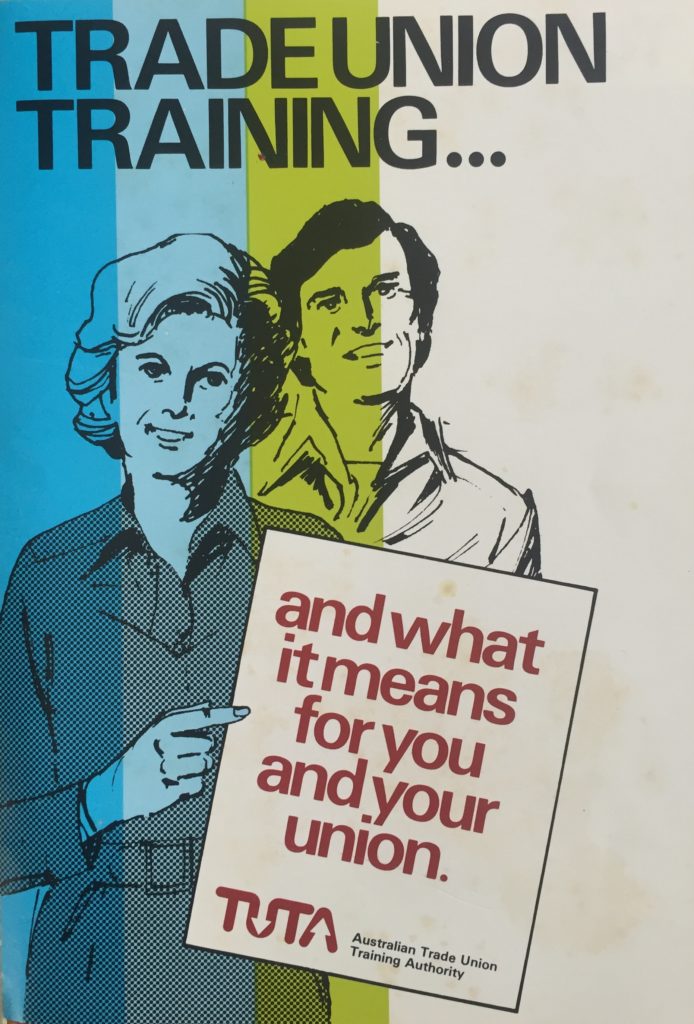By Professor Anthony Forsyth, RMIT
The establishment of the Trade Union Training Authority (TUTA) by the Whitlam Labor Government in 1975 signalled an important milestone in the form of government-funded worker education through a federal statutory agency. However, the promise offered by TUTA for increasing worker access to educational courses could only become a reality if union members and shop stewards were given paid time off work to attend the courses run by Clyde Cameron College and the TUTA state training centres.

Therefore, the development of legal rights to paid trade union training leave from the early 1970s – in parallel with the evolution of TUTA – was pivotal. Vehicle industry unions were the first to initiate claims for award clauses on union education leave in 1972. Although unsuccessful, these claims paved the way for vehicle unions and unions in other sectors to reach agreement with employers on union training leave, leading to the insertion of award provisions on a consent basis from around 1975. A typical clause from the
Chrysler Award read as follows:
The company will allow upon a request from an official of the union concerned, time off for shop stewards to attend trades union education courses up to a maximum of 5 working days in any one calendar year. The orientation courses of one day’s duration currently being run by the South Australian branch of The Vehicle Builders Employees Federation of Australia for newly appointed shop stewards shall be granted time off with pay and shall not be deducted from the period of 5 days mentioned above.
Over the next 15 years, federal and state industrial tribunals increasingly arbitrated in favour of union clams for paid training leave provisions in awards (some awards providing for up to 10 days’ leave per year). On one estimate, by 1986 there were 127 federal awards with provisions for paid education leave (including both consent and arbitrated award clauses). The following extract from a 1988 decision of the Conciliation and Arbitration Commission gives some insights into the principles behind the granting of award rights to paid union training leave and how the leave should operate in practice:
1 The clause should be confined to union delegates or representatives duly elected.
2 The employer affected by the leave should be advised and consulted as to the nature and content of the course to be attended.
3 Leave should be confined to five days in any calendar year. Such leave will not be cumulative.
4 The trade union training courses shall be those conducted by TUTA or as from time to time approved by TUTA and with the agreement of the parties.
5 The taking of leave shall be dependent upon the employer being able to make adequate staffing arrangements amongst his [sic] current employees.
6 The employer shall not incur any liability with respect to the cost of travel to and from the place where the courses are conducted nor to any accommodation cost during such leave.
7 For the purposes of the clause ‘pay’ shall be deemed to be ordinary time earnings as contemplated by the principle relating to superannuation of the current wage fixing principles.
In the Accord era, over time the Hawke Government’s support for TUTA – and paid education leave – was diluted to some degree by the wider project of economic reform and the advent of award restructuring, then enterprise bargaining. However, this did open up another source of legal rights to trade union training leave: provisions in enterprise agreements. The early years of formalised enterprise bargaining from 1992 did see the inclusion of paid leave provisions in some agreements, although such clauses were not to be found in the expanding number of non-union agreements.
The election of the Howard Coalition Government in 1996 spelled the end not only for TUTA, but for legal rights to paid trade union training leave. From mid-1998, such provisions were prohibited in federal awards, although some unions overcame this by obtaining award provisions for ‘dispute resolution training’ instead. Then, under the Coalition’s 2005 Work Choices legislation, bargaining over union training leave was also prohibited. These measures formed part of the Coalition’s full-scale legislative attack on the organisational, bargaining and collective action rights of unions.
The Rudd Labor Government removed the prohibition on enterprise agreement provisions for union training leave from mid-2009. As a result, almost 12,000 of the agreements negotiated between 1 July 2009 and 9 December 2021 included provisions for ‘union training leave’, ‘union education leave’, ‘industrial training leave’ or ‘shop stewards leave’. This is a typical clause, from a 2019 agreement negotiated by the Australian Nursing and Midwifery Federation:
3.7 TRADE UNION TRAINING LEAVE
3.7.1 Members of the ANMF, who are elected as Worksite Representatives, shall be allowed five (5) full days per financial year to attend Trade Union Training. Fourteen days notice must be given to the employer.
3.7.2 All applications for leave must be made in writing detailing:
– the name of the employee seeking leave
– period of time for which leave is sought
– title and description
– the place or places where the said course will be held.
3.7.3 Leave of Absence granted pursuant to this clause, shall count as service for all purposes of this Agreement.
3.7.4 Any days or hours taken for such training will be paid at the employee’s ordinary rate of pay.
3.7.5 All expenses (such as travel, accommodation and meals) associated with or incurred by the employee attending a training course as provided for in this clause shall [be] the responsibility of the employee or the Union.
3.7.6 An employee may be required to satisfy the employer of attendance at the course to qualify for payment of leave.
The right to paid leave to attend educational courses, enabling workers to obtain knowledge and skills to represent union members and negotiate with management on a more equal footing, is now established on a fairly widespread basis in the unionised sectors of Australia’s economy. Our study shows that the rise, fall and partial revival of the right to trade union training leave has been closely linked to the shifting position of Coalition and Labor governments towards trade unions over the last 50 years.
For further details see: Renee Burns, Anthony Forsyth, Alice Garner and Mary Leahy, ‘The Evolution of the Regulatory Framework for Trade Union Training in Australia’ (2022) 35:2 Australian Journal of Labour Law 95-118.
